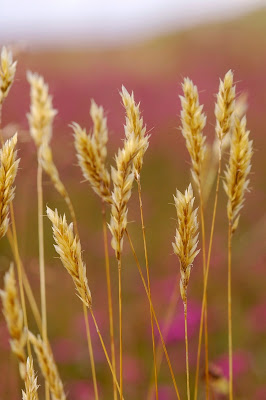I walked from Duntocher to the Test again, taking the longer route above Little Round Top Wood to avoid the boisterous bullocks in the fields below. This route is short yet encompasses a wide variety of habitats (Ash/Hazel woodland, gorse scrub, dry grassland, damp flower-rich meadows, moorland and reedy willowy marshland).
 |
| Marsh Ragwort (Senecio aquaticus) |
 |
| Marsh Ragwort (Senecio aquaticus)
|
Despite receiving lots of bad press, both Marsh Ragwort (
Senecio aquaticus) and Common Ragwort (
Senecio jacobaea) are native plants and are a vital food source for many insects (for example, the plume moth
Platyptilia isodactylus feeds ONLY on Marsh Ragwort).
 |
| Meadowsweet (Filipendula ulmaria) |
Meadowsweet is a sweet scented, non-toxic plant with analgesic (pain relieving) and antiseptic properties. Salicylic acid extracted from Meadowsweet was used by chemists at Bayer AG to synthesize a new painkiller - acetylsalicylic acid - which they named aspirin (derived from Meadowsweet's old genus name rearranged:
Spiraea).
 |
| Yarrow (Achillea millefolium) |
 |
| Yarrow (Achillea millefolium)
|
Yarrow has flat-topped clusters of potently aromatic flowers coloured either milky white or various shades of pink (from pale candyfloss to a deep raspberry icecream).
One of the most highly regarded plants in herbal medicine, Yarrow is antimicrobial/antiseptic, anti-inflammatory, antispasmodic, choleretic (increasing bile secretion), vasodilatory and promotes the healing of wounds.
Its feathery leaves are mentioned in its other common names Milfoil and Thousand-leaf and also in the species name
millefolium (
mille = thousand +
folium = leaf: Latin).
There were plenty of Meadow Brown butterflies on the wing and I managed to photograph one with its wings open for a change, revealing the foxy-orange patches and black eye-spots.
 |
| Meadow Brown (Maniola jurtina) female |
This individual is a female, males are a darker brown with much smaller orange patches.
 |
| Harebell (Campanula rotundifolia) |
In late summer the moorland is at its most vivid: heather is freshly magenta-purple or lilac and the wild grasses have dried to a crispy gold.
Above the Test there is mostly Bell Heather (
Erica cinerea) with some Cross-leaved Heather (
Erica tetralix) in the boggier parts.
I followed the old track (overgrown with Gorse) that leads down from the Test southeast to Little Round Top. At a marshy point to the side of this path I discovered a plant which I have never seen before: Knotted Pearlwort (
Sagina nodosa).
 |
| Knotted Pearlwort (Sagina nodosa) |
 |
| Knotted Pearlwort (Sagina nodosa) |
The key features identification features of Knotted Pearlwort are:
- Stubby bunches of leaf shoots which form 'knots' along the stems.
- Completely white (unnotched) petals twice as long as sepals (the green flaps underneath petals).
- 5 white centrally-placed styles surrounded by 10 white stamens.
Knotted Pearlwort's scientific name translates as 'Fodder, knotted' (
sagina = fodder,
nodosa = knotted: Latin).















Amazing images on your site - delicate and powerful at the same time!
ReplyDeleteDani @ ONNO Hemp Clothing